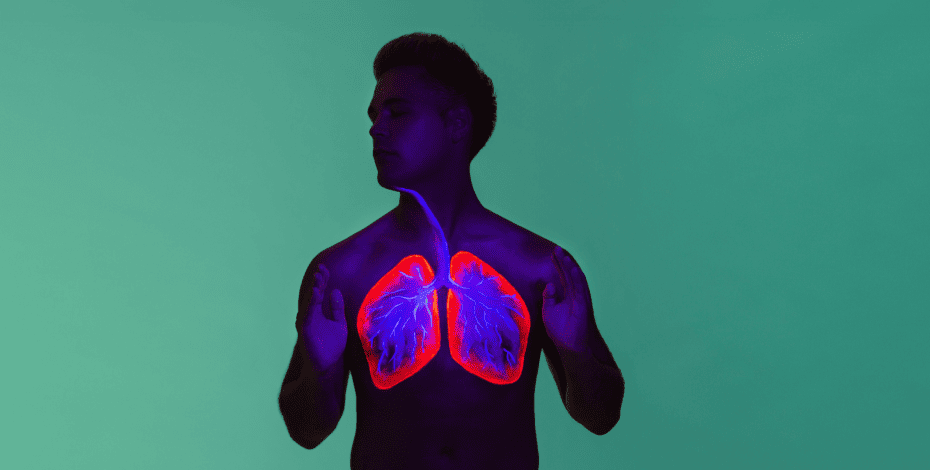
5 Facts: about aquatic physiotherapy

Dr Sophie Heywood, Clare Martinac and Manny Kwok present five discussion points about the physical, mental and social effects of aquatic physiotherapy and the benefits of exercise in this environment.
1. Aquatic HIIT increases exercise capacity for people with chronic conditions
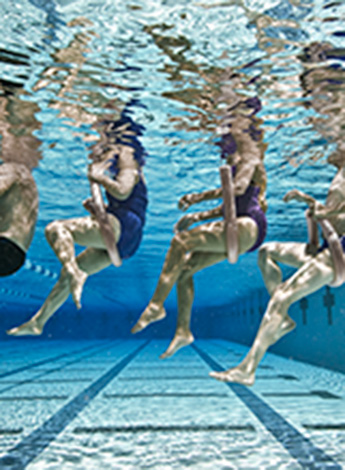
People taking part in aquatic exercise are supported by the water.
In a recent meta-analysis of 868 participants from 18 studies, aquatic high-intensity interval training (HIIT) was shown to improve exercise capacity in people with a range of chronic conditions (Bunæs-Næss et al 2023).
Aquatic HIIT showed similar benefits to land-based HIIT in improving exercise capacity and led to a moderate improvement in exercise capacity for people with chronic conditions compared to no exercise.
In people with chronic musculoskeletal, respiratory, cardiovascular, metabolic or neurological conditions, adherence to aquatic HIIT was high (84–100 per cent), indicating that it was well tolerated.
Exercises varied and included upper and lower body exercises, stationary running, cycling, jumping, deep water running, swimming and resistance boots and fins.
For people with chronic conditions, the aquatic environment is an effective alternative for HIIT (Bunæs-Næss et al 2023, Kwok et al 2022, Depiazzi et al 2019).
The physiological effects of hydrostatic pressure on the cardiac and respiratory systems may be factors in improving exercise capacity (Becker 2009).
Support from buoyancy may make exercise more feasible and enjoyable for people who are unable to train effectively on land by addressing barriers to HIIT, including weakness or pain, that affect exercise performance and intensity (Bunæs-Næss et al 2023, Kwok et al 2022, Depiazzi et al 2019).
2. Aquatic physiotherapy improves balance in stroke survivors

Aquatic exercises
There is growing interest in aquatic physiotherapy in stroke rehabilitation.
In the past four years alone, 10 systematic reviews focusing on a variety of outcomes following aquatic therapy have been published.
Each of these reviews assessed balance as an outcome, using land-based tests such as the Berg Balance Scale and the Functional Reach Test.
The largest review (Veldema & Jansen 2021), incorporating 28 studies with 961 participants, found that aquatic therapy was more effective than land-based interventions in improving balance.
Giuriati et al (2021) and Chae et al (2020) suggest that a lower risk and lower fear of falling with aquatic therapy may contribute to this effect.
The aquatic interventions varied greatly, from Halliwick and Ai Chi methods to strength, aerobic and balance activities, functional exercises, activities of daily living and task-specific work.
Change or improvement in balance may differ according to the intervention employed (Veldema & Jansen 2021) and further research may help to determine the optimal therapeutic intervention.
It seems clear, however, that for stroke survivors undergoing rehabilitation, aquatic physiotherapy is an evidence-based option for improving balance on land.
3. Stroke survivors say aquatic therapy improves physical and mental function
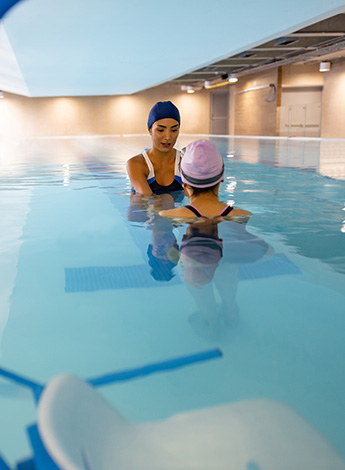
A patient is assisted in the water.
Stroke survivors may benefit both physically and mentally from participating in aquatic physiotherapy.
A recent qualitative study (Marinho-Buzelli et al 2023) revealed that stroke survivors perceive aquatic therapy as providing a safe environment that enables mobility and contributes to functional gains on land.
Clients and their healthcare professionals, including physiotherapists, referred to the freedom of movement that water provides.
Quotes from stroke survivors included ‘I learned to do things that I thought I would never do again… I walk across without someone holding on to me’ and ‘You do a little more in the water than you can on land and it transfers from the water to the land’.
Stroke survivors described the aquatic environment as a safe place to move and walk.
‘You fall in the water, you don’t get hurt.’
Benefits in socialisation and mental health were also reported by stroke survivors.
‘I learned how to be sociable again, because depression and anxiety really are terrible.’
The reported improvements are consistent with the results of two trials (Eyvaz et al 2018 and Matsumoto et al 2016), which found that stroke survivors who incorporated aquatic therapy into other therapy had significant improvements in both the social function and the mental health parameters of the Short Form 36 health survey.
4. Aquatic exercise promotes cerebral blood flow and brain health
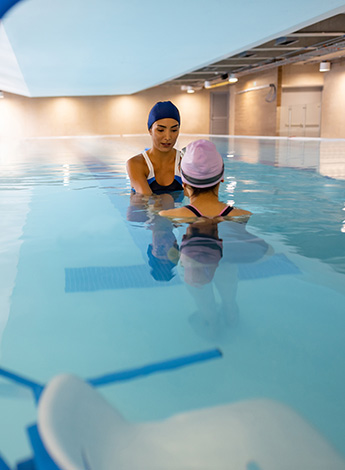
Aquatic exercise promotes cerebral blood flow and brain health.
Aquatic exercise increases cerebral blood flow.
Even water immersion at rest has been shown to enhance blood flow in the middle and posterior cerebral arteries (Carter et al 2014, Sato et al 2011).
The hydrostatic pressure exerted by water immersion facilitates the translocation of blood volume to the upper body, including the brain, which can improve cerebral perfusion and tissue oxygenation (Carter et al 2014).
Maintaining adequate cerebral blood flow is important for reducing the risk of neurodegenerative diseases such as dementia, which are associated with age-related decline in cerebral blood flow (Lautenschlager et al 2012).
Research has also explored the potential impact of aquatic exercise on neurotrophic factors, which play a crucial role in brain health.
These factors include brain-derived neurotrophic factor, insulin-like growth factor-1 and vascular endothelial growth factor (Kang et al 2020).
The results revealed that aquatic exercise significantly increased the levels of brain-derived neurotrophic factor, insulin-like growth factor-1 and cognitive function.
Consequently, aquatic exercise in the elderly population may enhance brain plasticity, reduce cognitive decline and promote overall brain health.
Aquatic exercise shows promise in terms of its effects on cerebral blood flow and brain health.
The responses of the brain to water immersion and exercise suggest that the environment may be beneficial for cognitive function, brain plasticity and cerebrovascular health.
5. Children with ADHD benefit from aquatic exercise
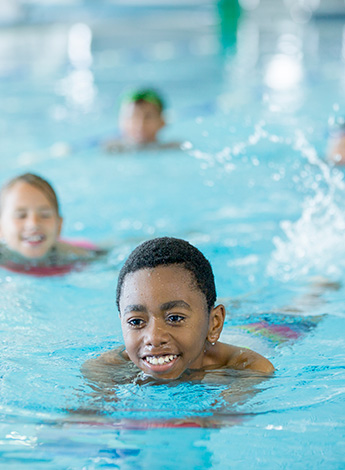
Children exercising in the water.
Physical activity and exercise have been recognised as a promising non-pharmacological approach for children with attention-deficit/hyperactivity disorder (ADHD) because they promote physical and psychological health, including fitness, mental wellbeing and executive function (Huang et al 2017, Lambez et al 2020).
Aquatic exercise stimulates the prefrontal cortex and amygdala, leading to improved attention and cognitive flexibility (Li et al 2023).
Being in water also demands constant attention to environmental fluctuations, which enhances cognitive engagement (Vivas et al 2011). The buoyancy provides a supportive and resistant environment, allowing some children to be more active and promoting greater motor skill development (Broach & Dattilo 1996).
In one study, an eight-week aquatic exercise intervention was implemented for children with ADHD, consisting of twice-weekly sessions (Chang et al 2014).
The results showed significant improvements in accuracy, motor skill coordination and impulsivity in the exercise group.
These findings highlight the value of carefully planned and quantified exercise, considering both intensity and dosage, in enhancing inhibition behaviour in children with ADHD.
Tailoring the exercise model and intensity based on factors such as age, behavioural characteristics and motor skills can also have a positive impact on attention and executive function.
The unique characteristics of aquatic exercise, such as constant attention demands and support, make it a beneficial option for this population.
>>Dr Sophie Heywood APAM MACP is an APA Sports and Exercise Physiotherapist. Sophie works at the Melbourne Sports Medicine Centre, Hydro Functional Fitness and St Vincent’s Hospital. Her current projects include clinical reasoning in aquatic physiotherapy, water exercise and wellbeing, trauma-informed care and promoting technology, engineering and innovation.
>>Clare Martinac APAM is an experienced physiotherapist who enjoys working with complex neurological clients. Clare works at Hydrotherapy Brisbane and is the chair of the Queensland branch of the APA Aquatic national group. She is passionate about educating clients and other physiotherapists about evidence-based aquatic physiotherapy.
>>Manny Kwok is a PhD candidate at the Hong Kong Polytechnic University whose research examines the impact of aquatic HIIT on cardiometabolic outcomes in older women. Manny recently completed the APA Aquatic Physiotherapy Level 3 course, extending her interest in aquatic exercise for people of all ages.
Quick links:
- References
- Infographic poster of this article.
© Copyright 2024 by Australian Physiotherapy Association. All rights reserved.





